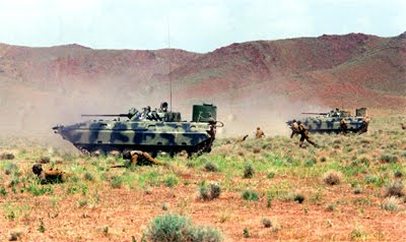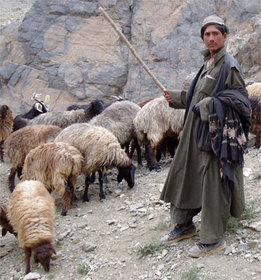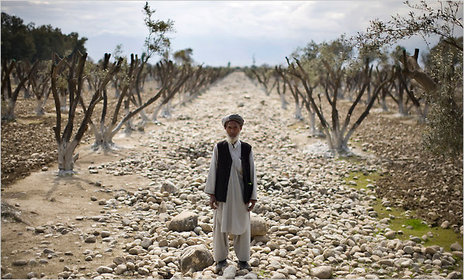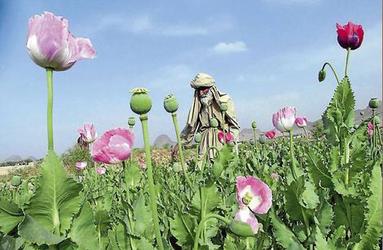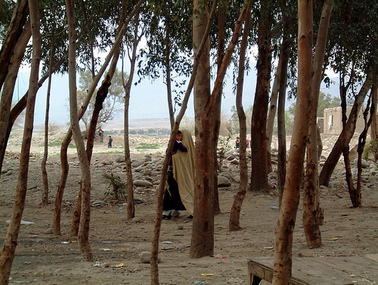Afghanistan Agriculture in the 1980s
The Photographer is centered on the events that happened in Afghanistan in the 1980s. With the Soviet Union invading Afghanistan in the 1980s, agriculture had become so unsettled that a truce was set up in 1983 to last until their July harvest in Panjshir Valley (“U.S Denounces Bombing Raids” 433).
The effect of the Soviet occupation on agriculture continued in 1984 as well. It was estimated that “500,000 people in Afghanistan were in danger of starvation”—especially in Soviet occupied areas—and the war caused shortages of meat, sugar, and oil (“Soviets Move Against Key Valley” 566).
The Soviet Union used agriculture against the guerilla fighters in 1984 by “target[ing] civilian villages, crops, livestock and
irrigation systems in the valley” of Panjshir (“Rebel Counteroffensive Claimed” 875). In Afghanistan: The Soviet War by Edward R. Girardet, the author recalls, “the bomb-shattered houses were crumbling and the once lush irrigated fields and fruit orchards were little more than dustbowls”(34).
Towards the end of 1986, Didier Lefèvre of The Photographer came to Afghanistan. By 1988, “one-third of Afghanistan’s land had been destroyed,” the “crops produced on the land still being farmed had dropped 35%,” and food production dropped by about half of what it was before occupation (“Rand Report Faults Soviet Army” 561). As for livestock, “the number of cattle had decreased by 55%, the number of goats and sheep by 66%, and the number of horses by 45%” (“Rand Report Faults Soviet Army” 561).
In Afghanistan, opium was popularly produced and still is today. In 1989, it ranked second in the world for opium production and the Bush administration urged rebel leaders to stop selling and producing it (“Asian News in Brief” 277).
Though the following information is current, much of the agriculture now is similar to when The Photographer was written. Today, Afghan farmers use out-of-date methods and tools while other Afghans are “nomads, who roam the country with their herds of sheep and goats”(“Afghanistan” 92). Around “85% of all Afghan workers earn their living in agriculture,” so it is a very necessary to their existence (“Afghanistan” 94).
The Photographer is centered on the events that happened in Afghanistan in the 1980s. With the Soviet Union invading Afghanistan in the 1980s, agriculture had become so unsettled that a truce was set up in 1983 to last until their July harvest in Panjshir Valley (“U.S Denounces Bombing Raids” 433).
The effect of the Soviet occupation on agriculture continued in 1984 as well. It was estimated that “500,000 people in Afghanistan were in danger of starvation”—especially in Soviet occupied areas—and the war caused shortages of meat, sugar, and oil (“Soviets Move Against Key Valley” 566).
The Soviet Union used agriculture against the guerilla fighters in 1984 by “target[ing] civilian villages, crops, livestock and
irrigation systems in the valley” of Panjshir (“Rebel Counteroffensive Claimed” 875). In Afghanistan: The Soviet War by Edward R. Girardet, the author recalls, “the bomb-shattered houses were crumbling and the once lush irrigated fields and fruit orchards were little more than dustbowls”(34).
Towards the end of 1986, Didier Lefèvre of The Photographer came to Afghanistan. By 1988, “one-third of Afghanistan’s land had been destroyed,” the “crops produced on the land still being farmed had dropped 35%,” and food production dropped by about half of what it was before occupation (“Rand Report Faults Soviet Army” 561). As for livestock, “the number of cattle had decreased by 55%, the number of goats and sheep by 66%, and the number of horses by 45%” (“Rand Report Faults Soviet Army” 561).
In Afghanistan, opium was popularly produced and still is today. In 1989, it ranked second in the world for opium production and the Bush administration urged rebel leaders to stop selling and producing it (“Asian News in Brief” 277).
Though the following information is current, much of the agriculture now is similar to when The Photographer was written. Today, Afghan farmers use out-of-date methods and tools while other Afghans are “nomads, who roam the country with their herds of sheep and goats”(“Afghanistan” 92). Around “85% of all Afghan workers earn their living in agriculture,” so it is a very necessary to their existence (“Afghanistan” 94).
Livestock and Byproducts
Most livestock is taken care of by the country’s “nomadic and semi-nomadic people” (“Afghanistan” 94). Common animal byproducts of Afghanistan “are dairy items, mutton, wool, and animal hides” (“Afghanistan” 94). Of all the domesticated animals in Afghanistan, sheep are the “most important…followed by goats, camels, donkeys, cattle, and horses” (“Economy” 249).
It is estimated that there are about “20 million sheep in the country” (“Economy” 249). Among the breeds of sheep in Afghanistan, the most popular is the fat tailed karakul sheep—used mainly for their hide. The most lucrative use of karakul sheep is the hide of their lambs. Either shortly before birth or up to three days after birth, karakul lambs are killed for their silky hides. According to the stock raising section in Encyclopedia Americana, around “5 million karakul sheep are raised…and the skins of the stillborn or young lambs constitute Afghanistan’s principle export” (“Economy” 249). Wool from the sheep is used for wool products, cloth, and rugs. Nomadic people use camels to follow their goats and sheep from one grazing area to another and “horses are highly regarded” as well (“Economy” 249).
Most livestock is taken care of by the country’s “nomadic and semi-nomadic people” (“Afghanistan” 94). Common animal byproducts of Afghanistan “are dairy items, mutton, wool, and animal hides” (“Afghanistan” 94). Of all the domesticated animals in Afghanistan, sheep are the “most important…followed by goats, camels, donkeys, cattle, and horses” (“Economy” 249).
It is estimated that there are about “20 million sheep in the country” (“Economy” 249). Among the breeds of sheep in Afghanistan, the most popular is the fat tailed karakul sheep—used mainly for their hide. The most lucrative use of karakul sheep is the hide of their lambs. Either shortly before birth or up to three days after birth, karakul lambs are killed for their silky hides. According to the stock raising section in Encyclopedia Americana, around “5 million karakul sheep are raised…and the skins of the stillborn or young lambs constitute Afghanistan’s principle export” (“Economy” 249). Wool from the sheep is used for wool products, cloth, and rugs. Nomadic people use camels to follow their goats and sheep from one grazing area to another and “horses are highly regarded” as well (“Economy” 249).
Crops and Produce
In Afghanistan, the primary crop is wheat. The “other crops include barley, corn, cotton, fruits, nuts, rice, sugar beets, and vegetables” but production is restricted from lack of “modern equipment, fertilizer, and high-quality seeds” (“Afghanistan” 94). Other less grown crops include “rye, millet, alfalfa, clover, beans, and peas” (“Economy” 249). All this has to be done with little irrigation and often in a hostile climate. Vegetables grown include “potatoes, onions, cabbages, eggplant, squash, and turnips” which are sold primarily in local markets (“Economy” 249). Afghans take pride in the taste and varieties of
their fruits that include “apricots, cherries, apples, quinces, red and yellow figs, pomegranates, and mulberries” (“Economy” 249). In the south, “oranges, lemons, and bananas” are grown and in various parts of the country melons and several types of grapes are grown (“Economy” 294).
In Afghanistan, the primary crop is wheat. The “other crops include barley, corn, cotton, fruits, nuts, rice, sugar beets, and vegetables” but production is restricted from lack of “modern equipment, fertilizer, and high-quality seeds” (“Afghanistan” 94). Other less grown crops include “rye, millet, alfalfa, clover, beans, and peas” (“Economy” 249). All this has to be done with little irrigation and often in a hostile climate. Vegetables grown include “potatoes, onions, cabbages, eggplant, squash, and turnips” which are sold primarily in local markets (“Economy” 249). Afghans take pride in the taste and varieties of
their fruits that include “apricots, cherries, apples, quinces, red and yellow figs, pomegranates, and mulberries” (“Economy” 249). In the south, “oranges, lemons, and bananas” are grown and in various parts of the country melons and several types of grapes are grown (“Economy” 294).
Opium
Afghanistan grows so many poppies for opium and heroin production that a leading grower in the world. Since “greater profits [are] found in the market for illegal drugs,” land originally used for growing grains is now used for poppy production
(“Agriculture” 29). According to the agriculture section in the 2003 World Book, the Taliban began to ban poppy production in 2000; unfortunately, in 2001—when the Taliban lost power—poppy production continued (“Afghanistan” 94).
Before the planting of poppies, cotton was grown more and used for textiles to be exported (“Afghanistan” 29). Another drug grown in Afghanistan is tobacco which has an annual production of “15,000 tons” (“Economy” 249).
Afghanistan grows so many poppies for opium and heroin production that a leading grower in the world. Since “greater profits [are] found in the market for illegal drugs,” land originally used for growing grains is now used for poppy production
(“Agriculture” 29). According to the agriculture section in the 2003 World Book, the Taliban began to ban poppy production in 2000; unfortunately, in 2001—when the Taliban lost power—poppy production continued (“Afghanistan” 94).
Before the planting of poppies, cotton was grown more and used for textiles to be exported (“Afghanistan” 29). Another drug grown in Afghanistan is tobacco which has an annual production of “15,000 tons” (“Economy” 249).
Lumber
Most people think of Afghanistan being a dessert, well most of it is. In Afghanistan, “forests cover about 3 percent of the total land area” (“Agriculture” 29). The “woodlands in the east consist mainly of conifers” which provides “timber for the building industry as well as some wild nuts for export” (“Agriculture” 29). Most other trees are used for firewood. In some areas, pistachio trees grow as well.
Most people think of Afghanistan being a dessert, well most of it is. In Afghanistan, “forests cover about 3 percent of the total land area” (“Agriculture” 29). The “woodlands in the east consist mainly of conifers” which provides “timber for the building industry as well as some wild nuts for export” (“Agriculture” 29). Most other trees are used for firewood. In some areas, pistachio trees grow as well.
Works Cited
“Afghanistan.”The World Book Encyclopedia. 2003 Edition. 2003.
“Agriculture.”The New Encyclopædia Britannica. Fifteenth Edition. 2010.
“Asia News in Brief.” Facts on File Yearbook. Volume 49. 1989.
“Economy.” Encyclopedia Americana. Volume 1. 1997.
Girardet, Edward R. Afghanistan: The Soviet War. New York: St. Martin’s Press, 1985. Print.
“Rand Report Faults Soviet Army.” Facts on File Yearbook. Volume 48. 1988.
“Rebel Counteroffensive Claimed.” Facts on File Yearbook. Volume 44. 1984.
“Soviets Move Against Key Valley.” Facts on File Yearbook. Volume 44. 1984.
“U.S. Denounces Bombing Raids.” Facts on File Yearbook. Volume 43. 1983.
Author: Katria Dony
September 27, 2011
“Afghanistan.”The World Book Encyclopedia. 2003 Edition. 2003.
“Agriculture.”The New Encyclopædia Britannica. Fifteenth Edition. 2010.
“Asia News in Brief.” Facts on File Yearbook. Volume 49. 1989.
“Economy.” Encyclopedia Americana. Volume 1. 1997.
Girardet, Edward R. Afghanistan: The Soviet War. New York: St. Martin’s Press, 1985. Print.
“Rand Report Faults Soviet Army.” Facts on File Yearbook. Volume 48. 1988.
“Rebel Counteroffensive Claimed.” Facts on File Yearbook. Volume 44. 1984.
“Soviets Move Against Key Valley.” Facts on File Yearbook. Volume 44. 1984.
“U.S. Denounces Bombing Raids.” Facts on File Yearbook. Volume 43. 1983.
Author: Katria Dony
September 27, 2011
